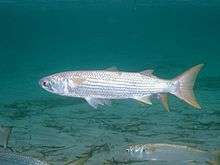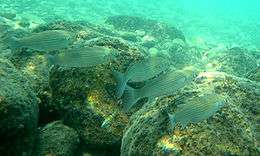Mullet (fish)
| Mullets | |
|---|---|
 | |
| Mugil cephalus at Minorca, Spain | |
| Scientific classification | |
| Kingdom: | Animalia |
| Phylum: | Chordata |
| Class: | Actinopterygii |
| Order: | Mugiliformes L. S. Berg, 1940 |
| Family: | Mugilidae G. Cuvier, 1829 |
| Genera | |
| |
The mullets or grey mullets are a family (Mugilidae) and order of ray-finned fish found worldwide in coastal temperate and tropical waters, and in some species in fresh water.[1] Mullets have served as an important source of food in Mediterranean Europe since Roman times. The family includes about 80 (at least 73) species in 25 genera.[2]
Mullets are distinguished by the presence of two separate dorsal fins, small triangular mouths, and the absence of a lateral line organ. They feed on detritus, and most species have unusually muscular stomachs and a complex pharynx to help in digestion.[1]
Classification and naming

Taxonomically, the family is currently treated as the sole member of the order Mugiliformes, but as Nelson says, "there has been much disagreement concerning the relationships" of this family.[3] The presence of fin spines clearly indicates membership in the superorder Acanthopterygii, and in the 1960s, they were classed as primitive perciforms,[4] while others have grouped them in Atheriniformes.
In North America, "mullet" by itself usually refers to Mugilidae. In Europe, the word "mullet" is usually qualified, the "grey mullets" being Mugilidae and the "red mullets" or "surmullets" being Mullidae, notably members of the genus Mullus, the red mullets. Outside Europe, the Mullidae are often called "goatfish". Fish with common names including the word "mullet" may be a member of one family or the other, or even unrelated such as the freshwater white sucker (Catostomus commersonii).

Timeline

Behavior
A common noticeable behavior in mullet is the tendency to leap out of the water. There are two distinguishable types of leaps: a straight, clean slice out of the water to escape predators and a slower, lower jump while turning to its side that results in a larger more distinguishable splash. The reasons for this lower jump are disputed, but have been hypothesized to be in order to gain oxygen rich air for gas exchange in a small organ above the pharynx.[5]
References
- 1 2 Johnson, G.D. & Gill, A.C. (1998). Paxton, J.R. & Eschmeyer, W.N., eds. Encyclopedia of Fishes. San Diego: Academic Press. p. 192. ISBN 0-12-547665-5.
- ↑ Durand, J.-D., W.-J. Chen, K.-N. Shen, C. Fu, & P. Borsa. 2012. Genus-level taxonomic changes implied b mitochondrial phylogeny of grey mullets (Teleostei: Mugilidae). Comptes Rendus Biologies 335: 687-697.
- ↑ "Fishes of the World, 4th Edition". Wiley. Retrieved 2012-04-12.
- ↑ Gosline, W. A. (1961) "The Perciform Caudal Skeleton" Copeia 1961(3): pp. 265-270
- ↑ "Gale - Enter Product Login". go.galegroup.com. Retrieved 2016-10-04.
- J.S. Nelson, Fishes of the World. ISBN 978-0-471-25031-9.
- Froese, Rainer, and Daniel Pauly, eds. (2012). "Mugilidae" in FishBase. June 2012 version.
- Sepkoski, Jack (2002). "A compendium of fossil marine animal genera". Bulletins of American Paleontology. 364: 560. Retrieved 2011-05-19.
- SPECIES BY FAMILY/SUBFAMILY IN THE CATALOG OF FISHES
External links
| Wikisource has the text of the 1905 New International Encyclopedia article Mullet (fish). |


.png)
